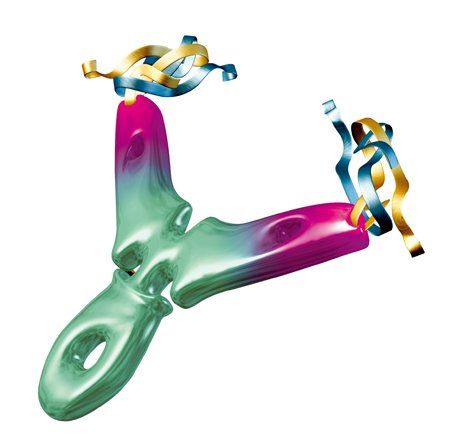Adding Bevacizumab to Endocrine Therapy No Help in Advanced Breast Cancer
The addition of bevacizumab to endocrine therapy did not prolong survival in postmenopausal women with advanced HER2-negative, HR–positive breast cancer.
Representation of bevacizumab molecule; source: Roche

The addition of bevacizumab did not prolong progression-free survival (PFS) or overall survival in postmenopausal women with HER2-negative, hormone receptor–positive advanced breast cancer treated with first-line endocrine therapy.
The results of the Letrozole/Fulvestrant and Avastin (LEA) study were published in the Journal of Clinical Oncology.
The median PFS was 14.4 months in the endocrine therapy arm and 19.3 months in the endocrine therapy plus bevacizumab arm (hazard ratio = 0.83; P = .126). The overall response rate was 22% and 41% in the control arm and the bevacizumab arm (P < .001). The duration of response was 13.3 months in the control arm compared with 17.6 months in the bevacizumab arm (P = .434). The time to treatment failure and overall survival were similar in both treatment arms.
Study author Miguel MartÃn, MD, PhD, of Complutense University of Madrid told Cancer Network that there was a trend towards a better PFS in favor of the combination of bevacizumab and hormones. “Therefore, we cannot simply conclude that bevacizumab is ineffective in this setting.”
“One of the relatively surprising things we found in the LEA trial is that the PFS of the control group was greater than expected,” said MartÃn. The high PFS in the control arm likely affected the results, as the sample size of the study was calculated based on a PFS assumption that turned out to be erroneous, added MartÃn.
“When we designed the LEA trial we established that the incremental benefit on PFS obtained by adding bevacizumab to hormones should be big enough to justify the inconveniences associated with the intravenous administration of bevacizumab and the toxicity of the drug,” said MartÃn.
The open-label trial conducted in Spain and Germany analyzed 374 intent-to-treat patients. The median age of patients was 65 years; 48% had visceral metastases. Fifty-two percent of patients had received prior chemotherapy. Bevacizumab was given at a 15-mg/kg dose every 3 weeks until disease progression, and no dose reductions of the antibody or endocrine therapy were permitted.
Grade 3 or 4 hypertension, aminotransferase elevation, and proteinuria were significantly higher in the bevacizumab arm. Hypertension occurred in 15% of patients in the bevacizumab arm compared with 3% of patients in the control arm (P < .001). Five patients experienced thromboembolic events of any grade; four were in the bevacizumab arm. More serious adverse events were seen in the bevacizumab treatment arm-64 events in 48 patients compared with 21 events in 17 patients in the control arm (P < .05). Eight patients (4.2%) in the bevacizumab arm died during the study or within 30 days of ending therapy from a pulmonary embolism, heart failure, cerebellum infarction, stroke, liver failure, or acute myocardial infarction. One patient died of unknown causes.
The impetus for the study was prior preclinical evidence and a few uncontrolled clinical studies in the neoadjuvant setting that suggested a synergism between bevacizumab and hormonal therapy, MartÃn told Cancer Network. “The LEA trial is the first randomized trial aimed at exploring the interest of the combination of bevacizumab and hormonal therapy in a formal way,” he said.
According to MartÃn, identifying markers that could predict a response to bevacizumab will be important in defining the drug’s role in metastatic breast cancer, but, unfortunately, researchers have yet to identify any such factors.
The Cancer and Leukemia Group B (CALGB) 40503 trial, which has a similar trial design to the LEA trial but with a larger sample size and greater statistical power, will be completed soon. “[This trial will] provide significant additional information about the interest of combining bevacizumab and hormones,” said MartÃn.